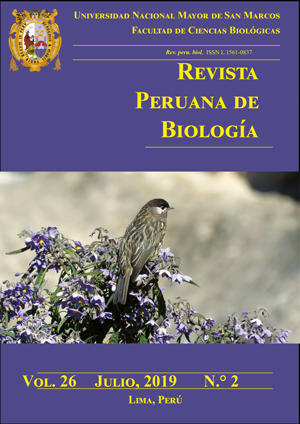State of conservation de Myrcianthes ferreyrae an endemic tree of the coastal hills of southern Peru
DOI:
https://doi.org/10.15381/rpb.v26i2.16380Keywords:
Peruvian desert, regeneration, coastal hills, conservation, extinction, MyrtaceaeAbstract
Myrcianthes ferreyrae (McVaugh) McVaugh, "arrayan" is an endemic and threatened tree of the “lomas” formations of south Peru. We evaluated their conservation status between March 2011 to August 2012; for which, all individuals were counted in its distributional range known (Atiquipa, Taymara and Chala Viejo hills in the Province of Caraveli, Arequipa). We established 9 plots of 0.25 hectares, three in each locality; in each plot we obtained data of all trees greater than 10 cm basal diameter, plus mortality parameters, its natural regeneration and presence of disturbances. Myrcianthes ferreyrae has a population of 586 individuals, its diameter distribution shows a bell form, the most common category mortality was logging; the natural regeneration was 33.12%, all belonging to the Atiquipa hills. We conclude that M. ferreyrae is strongly threatened, formed by adult individuals and with little natural regeneration. In management of M. ferreyrae should be considered its fragility and the problems it has for its regeneration.
Downloads
Downloads
Published
Issue
Section
License
Copyright (c) 2019 Fiorella N. Gonzales Guillén, Francisco Villasante Benavides

This work is licensed under a Creative Commons Attribution-NonCommercial-ShareAlike 4.0 International License.
AUTHORS RETAIN THEIR RIGHTS:
a. Authors retain their trade mark rights and patent, and also on any process or procedure described in the article.
b. Authors retain their right to share, copy, distribute, perform and publicly communicate their article (eg, to place their article in an institutional repository or publish it in a book), with an acknowledgment of its initial publication in the Revista Peruana de Biologia.
c. Authors retain theirs right to make a subsequent publication of their work, to use the article or any part thereof (eg a compilation of his papers, lecture notes, thesis, or a book), always indicating its initial publication in the Revista Peruana de Biologia (the originator of the work, journal, volume, number and date).






